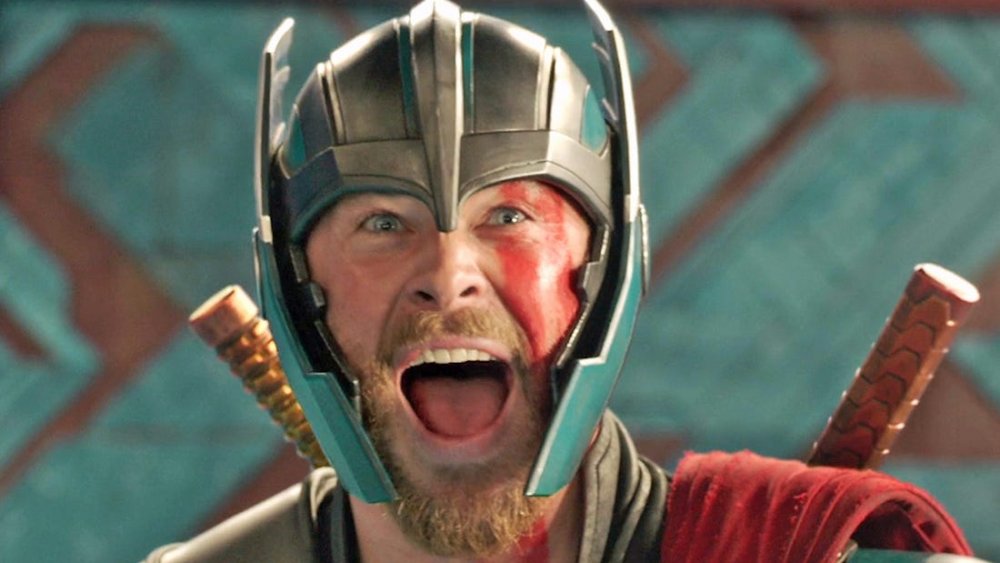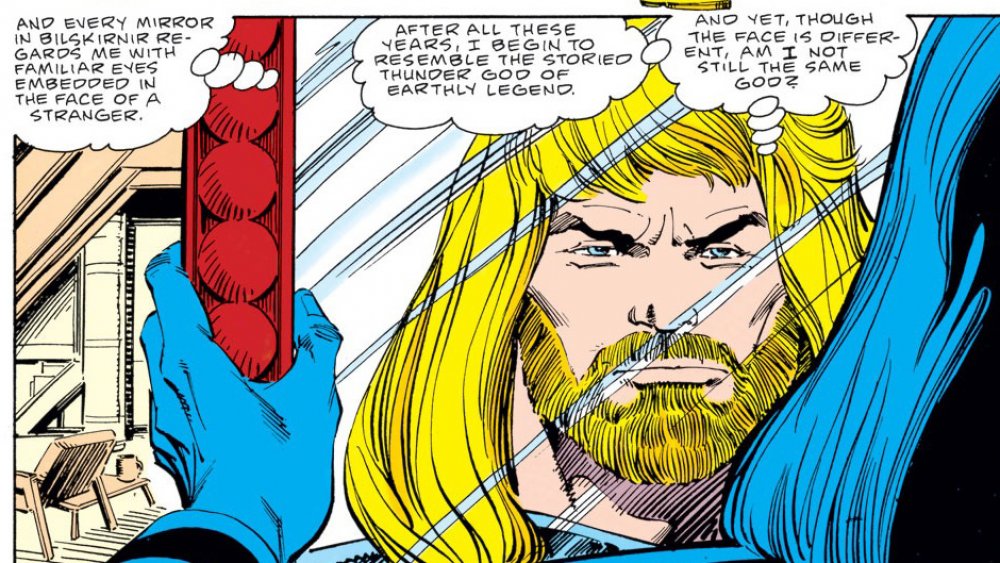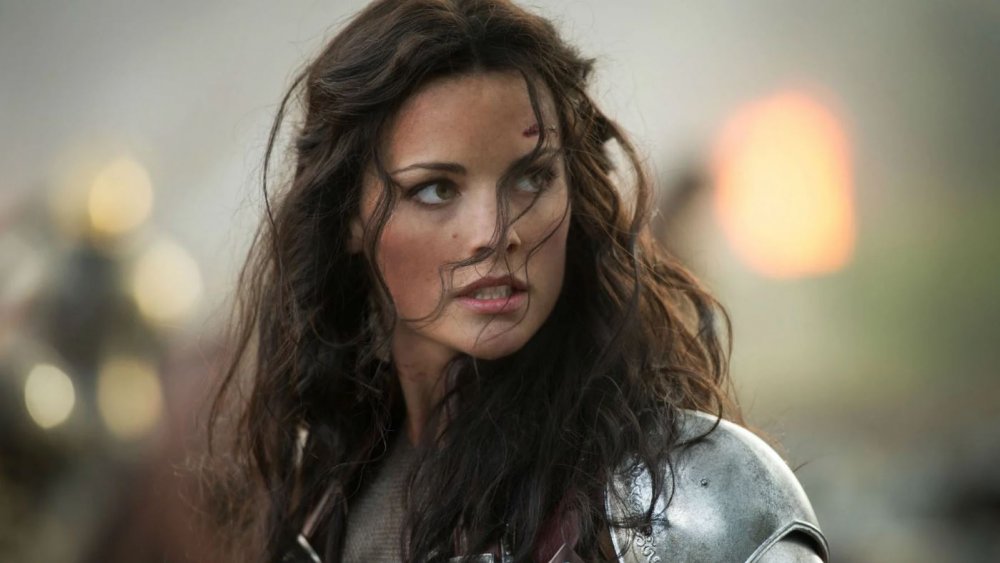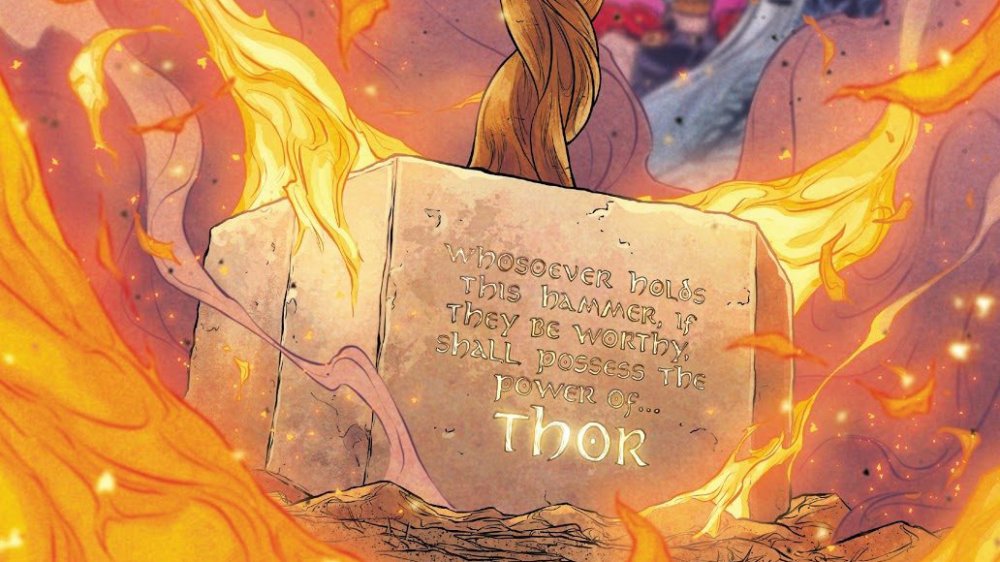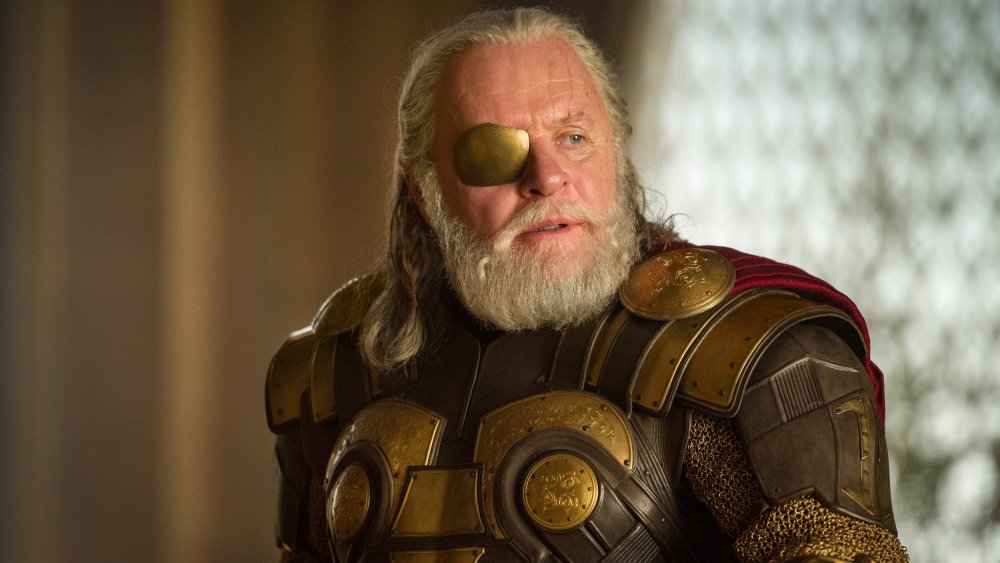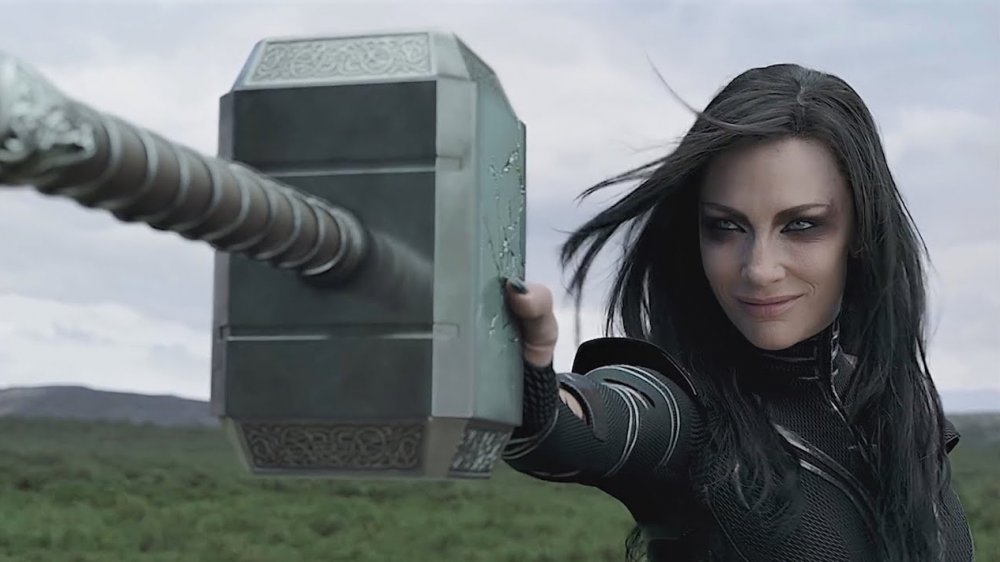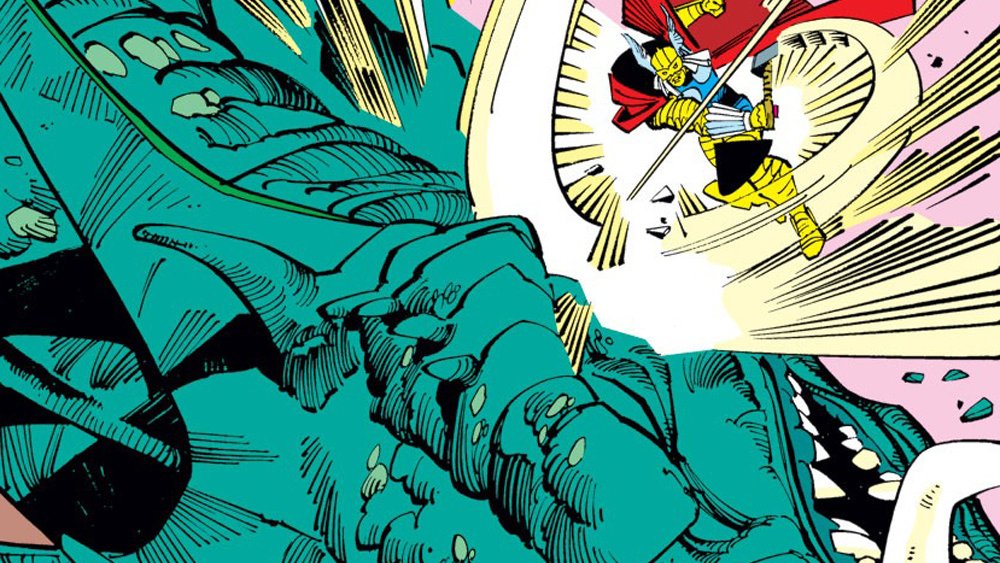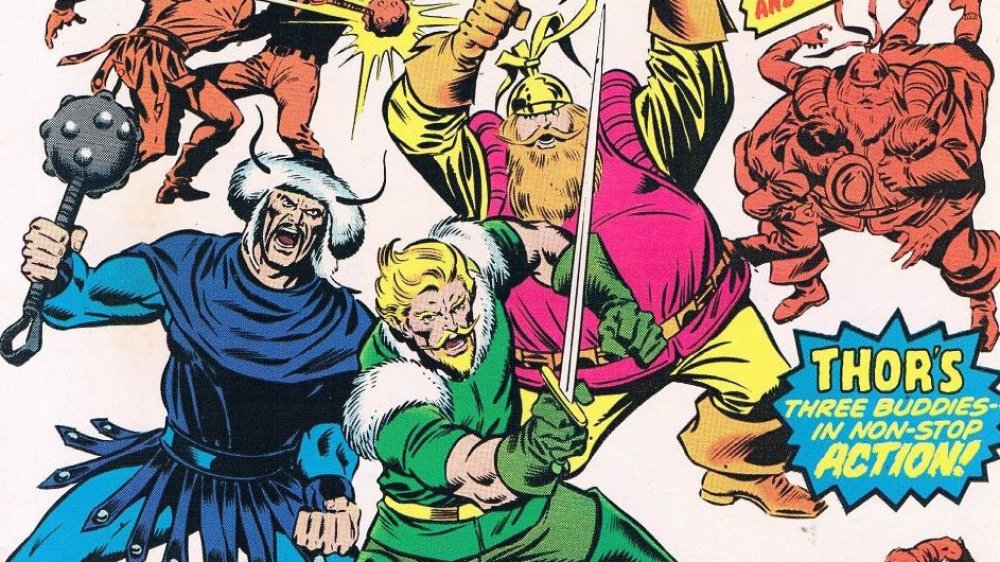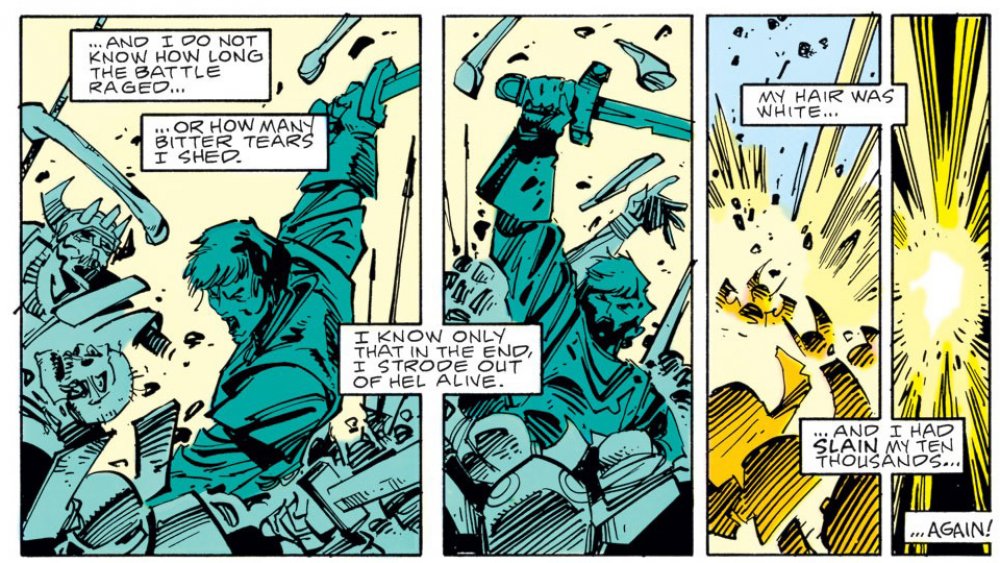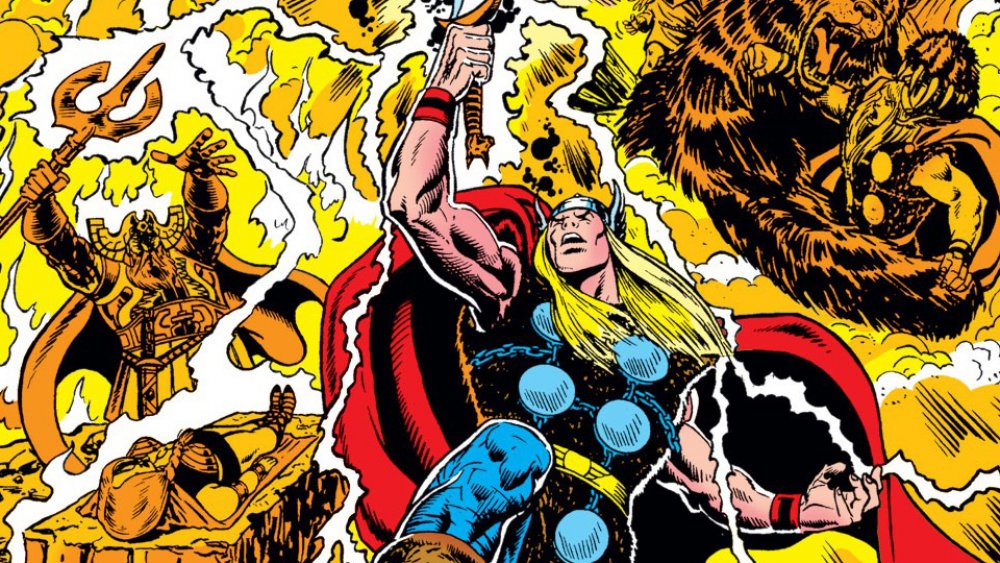Things Marvel Gets Wrong About Thor's Norse Mythology
For nearly 60 years, the version of Thor that we've seen in Marvel Comics and the movies based on them has been the most prominent image of the god of thunder in pop culture. The thing is, Thor as a legendary figure existed for about a thousand years before Stan Lee, Jack Kirby, and Larry Lieber added him to their brand new superhero universe, and not everything made it onto the page.
By and large, the Marvel Comics have done a surprisingly solid job of incorporating Norse mythology into their universe — even some of the weirder parts that you might not expect, like Ratatoskr, the talking squirrel god who lives in the World Tree — but there are definitely a few changes. After all, creating a superhero who can team up with Captain America to fight Dr. Doom is a very different process than the evolution of a figure through legend and beliefs. Here are the things that Marvel changed about Thor's Norse mythology.
Thor isn't a blond
The most obvious difference between Marvel's Thor and the original figure, at least from a visual standpoint, is his hair color. The Odinson who hangs out with the Avengers is famously blond, to the point of being nicknamed "Goldilocks" by a few of his teammates when they're feeling brave enough to throw shade at a guy who can shatter mountains with his magic hammer. The original version, however, is often depicted as having red hair, with a beard to match.
In Vikings: A History of the Northmen, W.B. Bartlett cites legends that refer to Thor as being "red-haired, red-bearded, red-eyed," and much of the artwork that was around long before Jack Kirby put his pencil on the page bears that out. German painter Max Koch's Donar-Thor, circa 1905, for instance, gives the thunder god flaming red hair. Also, if you need a more direct comparison, Marvel's version wasn't the first time that Kirby had drawn a story about Thor. Earlier in his career, he'd done two other versions, and the one that appeared in color had a red-haired look much more in line with the original character.
It's worth noting that this has even been addressed in the comics themselves, although the explanation might not be as satisfying as you want. Thor just says the legends got it wrong. As for the real-world reason why, that's never been explained, but it's easy to assume that it has to do with the costume design and the printing process of the time. The early Thor stories were essentially Marvel's take on Superman, which is reflected in his blue-and-yellow costume with the long red cape. If he had red hair, it would've blended in with the cape, confusing the visual and making it a lot less striking than the contrast of the yellow hair.
Marvel made quite a few changes to Sif
Marvel's depiction of Sif also has the distinction of having a different hair color than her mythological counterpart. In the comics, Sif has always had black hair, but in the mythology, her hair is golden — as in, literally made of gold. One of the most famous Norse myths is the story of how Loki cut off Sif's hair — because, you know, god of mischief and all that — and wound up replacing it with a new set of beautifully cascading locks that were magically crafted by dwarves. There's never been an official reason for Marvel's choice, but it's easy to assume that the change was made to make Sif more of a visual contrast with Thor on the comics page. There was, however, a suitably mythological in-continuity reason, in that Marvel's dwarves crafted her hair from the darkness of the night rather than gold.
The differences don't stop there, though. Sif in the comics is a fierce warrior, a shield-maiden of Asgard, as deadly in combat as Thor himself. With all due respect to the original Sif, that's not quite her classic portrayal. Neither the Prose Edda or the Poetic Edda gives her any fight scenes, instead characterizing her as more of an Earth goddess. In fact, many scholars suggest that Sif and Thor's marriage is symbolic of the necessity of rain for growing crops, which is barely even a metaphor.
That marriage is something else that's absent from the comics. Marvel's Thor and Sif are more on-again, off-again, depending on how the current creative team feels about Jane Foster. That relationship is also a pretty big departure from the myths of old. Unlike Greek mythology, there aren't a lot of dalliances between gods and humans in the Norse stories.
The truth about Thor's hammer
In the comics and the Marvel Cinematic Universe, some of the most longstanding and crucial elements of the stories are the mystical enchantment on Thor's hammer, Mjolnir. The hammer can only be lifted by the worthy, and when it is, it grants them the power of Thor, whether it's the Odinson or not. It's so important for his character that Marvel's Thor isn't just the god of thunder, he's the god of the unworthy, a symbol for everyone who strives to be better than they are.
It's such an intrinsic part of Thor's story that if you're not familiar with the mythology, it might surprise you to find out that it's entirely a creation of the comics — specifically Lee, Lieber, and Kirby — and was added to the story so that Thor could have a secret identity. The myths have no such enchantment, and the idea that it would be added in order to teach him humility doesn't really ring true, either. For all his quickness to anger, the Norse Thor was pretty popular, and all of his smiting generally had Odin's stamp of approval.
It is true that, mythologically speaking, Thor was the only one who could lift Mjolnir, but that wasn't because of an enchantment. It was because Mjolnir was just, you know, really heavy. So heavy, in fact, that Thor had two other special pieces of equipment, the Jarngreipr and the Megingjord — iron gloves and a belt of strength, respectively — to handle it. Those actually do exist in the comics, but they're more of an in-case-of-Ragnarok contingency than everyday wear. The Megingjord even has another enchantment, in that it doubles Thor's strength but leaves him severely weakened, to explain why he doesn't wear it all the time.
The Odin of Norse mythology isn't like the Marvel character at all
The version of Odin we see in the films comes across as a wise leader who reserves most of his fury for his children, notably Thor and Hela, whose violent tendencies break the fragile peace of the nine realms. In the myths, not so much.
It's not that Odin himself is particularly violent — by messed up Viking standards, anyway — but that Thor is almost always acting exactly in accordance with his father's wishes. Odin is, after all, the god of battle and death (and poetry and wisdom, a combination you don't usually see in other pantheons), and most of Thor's more famous myths involve going on quests because Odin tells him to. Odin himself does have some pretty raw tendencies, though, like the time he stabbed the witch Gulveig three times with his magic spear, burned her body, and then gave her heart to Loki, who ate it. That one ... did not make it into the MCU.
The comics actually go in the opposite direction. Rather than the wise, world-weary Anthony Hopkins of the MCU, the Odin on the page is extremely quick-tempered and has some epically violent actions in his past. One early story that created one of Thor's deadliest foes involved a distant past where Odin wiped out an entire planet because of its evil, causing the hatred of "a billion billion souls" to coalesce into a monster called the Mangog.
What the Hela?
Marvel's version of the Norse goddess of death has a pretty obvious distinction from her mythological counterpart, and it's right there in the name. Marvel named their version Hela, adding the "a" at the end, presumably to make it easier to distinguish Hel (the goddess) from Hel (the realm of the dead), and possibly to get around the Comics Code, which might've had a problem with the name. If that was the case, we can all probably agree that they made the right choice, as it would be a lot less intimidating for Thor to be fighting an immortal foe named Heck.
There are bigger differences, though. For one thing, she's not Odin's daughter. According to the Eddas, she's Loki's, with the giantess Angrboda. She's also depicted in a far more horrifying appearance than the one we saw in Thor: Ragnarok. As the goddess of the dead, she's described in the Prose Edda as being "half blue-black and half flesh-color (by which she is easily recognized)," which is sometimes interpreted as half of her body being alive and half being either a rotting corpse or a skeleton.
That depiction has made it into pop culture, too. The Hela of the comics is occasionally drawn with that appearance — one reason why her costume keeps the top half of her face covered — and the Dungeons & Dragons version of the goddess follows along those lines. Either way, it's a pretty far cry from Goth Cate Blanchett in Thor: Ragnarok.
Why did it have to be snakes?
One thing that distinguishes Norse mythology from other ancient belief systems is that we all know how it's going to end — with Ragnarok, the twilight of the gods, in which the enemies of Asgard assemble and the gods get their heroic deaths in glorious battle. Considering that they're still making new comics about Thor every month, it might surprise you that this happens in the comics, too. Several times, actually. In Marvel's mythology, Ragnarok is a cycle, and we're actually on our fifth or sixth incarnation of Thor and his godly pals.
There is one element of Ragnarok that's completely defied in the comics, though. The legends prophesize that Thor will die in battle against the Jormungandr, the Midgard Serpent, an absolutely terrifying snake large enough to encircle the entire world. Marvel's version of that fight went a little differently. In Thor #380, part of Walt Simonson's legendary and definitive run on the book, Thor battled Jormungandr and won. He didn't just win, though. Thor hit the Midgard Serpent so hard that it broke every bone in his own body. This is one of those rare cases where the comics are actually wildly more violent than the myths they're based on, and it totally rules.
Do the Warriors Three show up in Norse mythology?
Superheros have sidekicks. Batman has Robin, Captain America has Bucky, and Spider-Man has a haunting, omni-present sense of guilt and self-loathing that drives his every action. It's a convention of the genre! Thor is no exception, and while they don't always tag along on his adventures, he definitely has a trio of characters that could accurately be described as his sidekicks: the Warriors Three! Fandral the Dashing, Hogun the Grim, and Volstagg the ... well, let's be kind and call him "the Valiant" for now.
Unlike most of Thor's other Asgardian supporting cast, the Warriors Three aren't drawn from mythology at all. They're entirely the creation of Stan Lee and Jack Kirby, drawing on characters lifted from elsewhere. Fandral is a swashbuckler in the vein of Robin Hood, and Volstagg, who boasts of his own prowess roughly one million times harder than he actually fights, is loosely based on Sir John Falstaff, a character Shakespeare created for Henry IV.
In mythology, the closest thing that Thor has to sidekicks are his two sons, Modi and Magni, who occasionally accompany him on his adventures. Weirdly enough, the Prose Edda does contain a fragment of a lost myth where Thor is shown to be hanging out with the Incredible Hulk, though. (Okay, fine, we made that one up.)
What's up with Balder the Brave?
In mythology, Balder is often considered to be the most beautiful of the gods, and he also has one of the most tragic stories. In one of his few truly evil acts — as opposed to the pranks and general mischief that he's usually up to — Loki murders Balder and condemns him to Hel. See, when a prophecy foretold Balder's death, his mother, Frigga, extracted a promise from everything in the world that it would never hurt her son. The one exception was mistletoe, and wouldn't you know it, Loki found out and tricked another god, Hermod, into chucking a piece of it at the otherwise invulnerable Balder, killing him instantly. You may recognize this as the plot to 2018's God of War.
The same thing happened in the comics, but there were a few key differences. For one, Balder was less Balder the Beautiful and more Balder the Brave, Asgard's mightiest warrior. For another, he actually returned from Hel to Asgard, retiring from combat until he was forced back into it by another one of Loki's evil plots.
In one of the best moments of the run, readers found out why Balder had given up fighting. When he got to Hel, he was confronted by the souls of everything he'd ever killed, a considerable amount for Asgard's greatest warrior. To get out, he was forced to kill them all again, and as he said in Thor #360, "I did not walk out of Hel. I swam through the blood of warriors."
Thor has some weird secret identities
We've already mentioned Marvel's take on Norse mythology as being cyclical, so it won't be surprising to learn that Don Blake wasn't the first time that Thor found himself incarnated as a human. In what seems like an effort to tie their character into every piece of Norse-related mythology, Marvel once published a story about how Thor was previously incarnated as Siegfried, the dragon-slaying hero, probably best known from Richard Wagner's The Ring of the Nibelung.
The thing is, Siegfried — also called Sigurd, a name Thor later used in a short-lived secret identity that was just Thor wearing glasses — is a completely different mythological figure. In fact, he doesn't even have a hammer. His weapons of choice are a giant sword called Balmung and an invisibility cloak, making him more of the Norse mythological equivalent of Harry Potter than the equivalent of Thor. That same story revealed that the heroine Valkyrie wasn't just named Brunhilde, she was the Brunhilde from Siegfried's legend, having also been sent to Earth.
The weirdest part? Thor was also incarnated as SIegmund, Siegfried's father, making him, briefly, his own dad. Odin has some very strange ideas about how to teach his kids a lesson.
